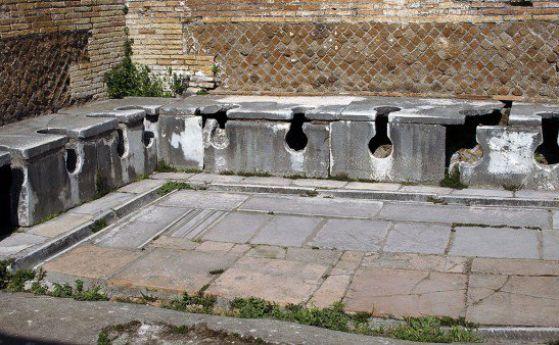Generally speaking, the Romans had fewer reservations than the people today. They are relatively okay with the narrower rooms – after all, the seats and the Roman theater are also quite close, about 30 centimeters apart. And they’re also okay with group walking.
“Today, when we take off our pants, we are left quite naked, but the Romans are wrapped in gowns, which provides them with cover,” said Koloski-Ostrow, an anthropologist at Brandeis University.
“The clothes they wear provide them with a barricade so that they can actually do their work in relative solitude, get up and leave. And let’s hope your toga hasn’t been much affected since. If we compare the toilets of that time with the modern urinal, she adds, they actually offer more privacy.
Despite the lack of toilet paper, visitors use sponges attached to a stick that they wash in clean running water.
The Romans loved comfort in such situations. Whether they washed their hands, however, is another story. Maybe they were immersed in an amphora of water. Maybe they aren’t. They may have done so in some parts of the empire, but not in others. What’s worse is that the sponge stick has probably been used repeatedly and shared by all visitors.
So, if one of the visitors has any diseases, everyone else catches them as well. Without knowledge of how diseases spread, the Roman toilet can hardly be called hygienic by modern standards. This soft, gentle tool is called a tersorium, which literally means “something to wipe.”
Although they seem advanced to an ancient civilization, Roman public toilets are far from particularly glamorous. The white marble seats, glistening in the sun, may look clean now, but that was hardly the case when these facilities were working. They have low roofs and small windows that let in little light.
People sometimes do not hit the holes, so the floors and seats are often dirty. The air stinks. “Think about it – how often does someone come to clean this marble?” Koloski-Ostrow asks. In fact, she believes that the facilities were so unpleasant that the elite of the empire used them only in very difficult situations.
The upper-class Romans, who sometimes paid for the construction of toilets, usually did not set foot in these places. They construct them for the poor and the enslaved – but not because they have mercy on the lower classes. They build them so they don’t have to walk in the excrement on the streets. Like any other civilization that chooses to urbanize, the Romans face a problem: What to do with all the waste?
The Roman elite viewed public toilets as an instrument that washed the filth of the plebeians from their noble gaze. In Roman baths it is common practice to write the name of the benefactor who paid for the construction of the facility, but the walls of the toilets do not bear such inscriptions. “It seems that no one in Rome wanted to be connected to a toilet,” says Koloski-Ostrow.
Public toilets were not comfortable for women either. In the 2nd century, “these places were built in areas of the city where men had jobs,” says Koloski-Ostrow.
“Perhaps a enslaved girl who was sent to the market would dare to enter, if necessary, although she would be afraid of being robbed or raped. But an elite Roman woman will never be seen there, even dead.
Back in their comfortable villas, wealthy citizens have their own toilets built over cesspools. But even they may have preferred the more convenient, less smelly version with the room pots that the enslaved people were then forced to empty in the garden.
The elite do not want to connect their cesspools with sewer pipes, because this will probably be a convenient route for pests and odors to their homes. Instead, they hire people to deal with their pits









